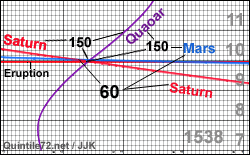|
Campi Flegrei is a collapsed volcano, also known as a caldera, partially located in the area of
Naples, Italy. According to Wikipedia, the caldera has a diameter of about 12 kilometers, and it
contains over 20 craters, from which hot water and gas burst out. "Campi Flegrei" means "burning
fields."
The volcanic area has been dormant for nearly 500 years, since it last erupted in 1538, an eruption
that lasted for eight days. However, signs of awakening have been detected since the 1950s. The
coastal city of Pozzuoli is located right on top of the volcano, where the Earth's crust slowly rises
and falls in response to changes in the underlying magma chamber. Small earthquakes are often
observed, and their frequency has increased in recent years.
In October 1983, a slightly stronger earthquake occurred, with a magnitude of 4. The ground had
risen by more than two meters, and 30,000 residents were evacuated from Pozzuoli in preparation
for a possible eruption.
In recent years, there has been much written about Campi Flegrei,
as it is considered dangerous due to the dense population in the
area. Therefore, it became necessary to study what cosmic factors
were behind the eruption of 1538, and whether Pluto had any role
in it. This is because Pluto was in it’s nodal point in October 2018,
when its effects also would have intensified.
Over the years, attention has been drawn to the fact that certain
planetary angular positions seem to particularly affect the
movement of magma, amplifying it. These angles are 0, 60, 120,
and 150 degrees. Under their influence, magma accumulates in
magma chambers, increasing pressure. Magma can also
accumulate at the boundaries of tectonic plates for the same
reason. After this, quintile angles, 36, 72, and 144 degrees, seem
to act as a "detonator," causing the volcano to suddenly erupt or
tectonic plates to break free from their tensioned state, resulting in
an earthquake. Below, we will examine these situations in the
case of Campi Flegrei.
Campi Flegrei in 1538
The eruption began on September 29, 1538. One of the striking
features of that day's planetary configurations is the involvement
of the "heat planet" Pluto. Pluto was nearly stationary as seen
from Earth and made almost an exact conjunction with the dwarf
planet Makemake, which was also nearly stationary. The
difference to a perfectly exact conjunction was only 12
arcminutes. Makemake represents the water element, and the caldera extends beneath the sea.
Makemake was far from its nodal point, and Pluto's descending node had occurred 15 years earlier,
in 1523. During the eruption, Pluto’s height from the ecliptic was 7 degrees 46 arcminutes, so the
node likely had no effect at this point.
Due to the slow movement of Pluto and Makemake, they seemed to form a tight "conjunction
dance" with their distance varying by only a few arcminutes over several years. This conjunction
effect must have maintained earthquake sensitivity for a long time and likely gradually increased
the pressure in the magma chamber beneath Pozzuoli, as the Earth's crust had risen by a total of 17
meters before the eruption.
So, what caused the eruption on precisely September 29, 1538? Certainly, there are
several factors that can be seen as contributing to the eruption.

On September 13, two weeks
before the eruption, Uranus and the dwarf planet Orcus made a half-quintile (36 degrees).
The adjacent image shows their orbits nearly parallel, creating a narrow pattern and long
lasting quintile effects. Orcus is Pluto’s "twin," and their thermal effects are very similar.
Furthermore, Orcus was still in the ethereal heat zone at the time. Uranus’ light influence
amplified Orcus’ heat, and quintile angles often lead to dramatic effects. This may have opened the path for the eruption.
On the exact day of the eruption, a quincunx (150 degrees) occurred between Saturn and the
dwarf planet Quaoar. In addition to Saturn’s heat, Quaoar's earthy quality may have
affected the Earth's crust in the surrounding area.
|









